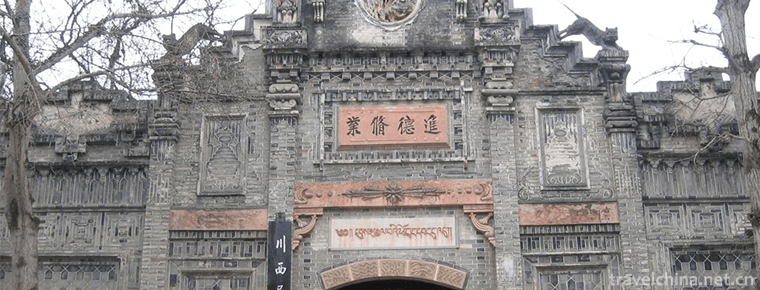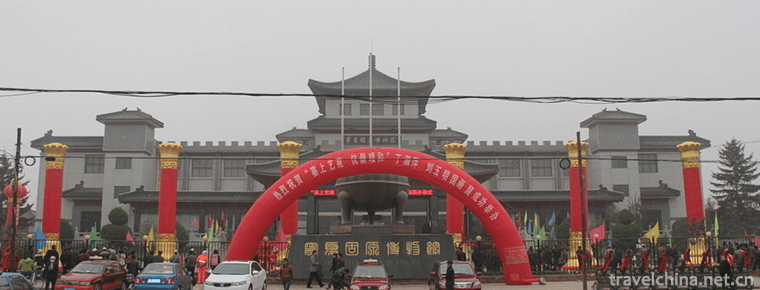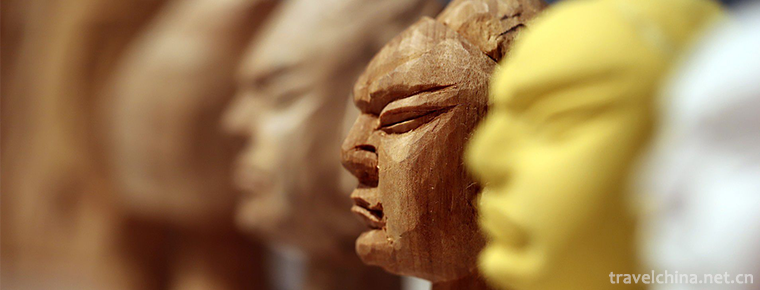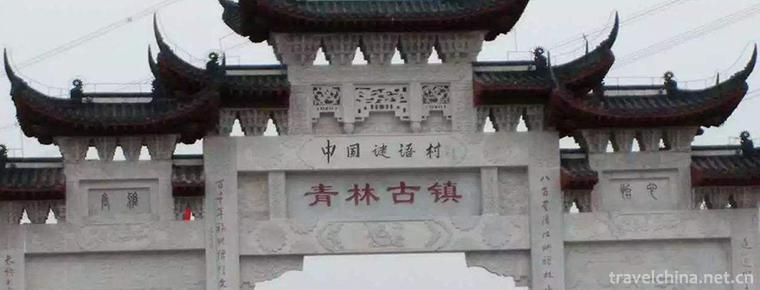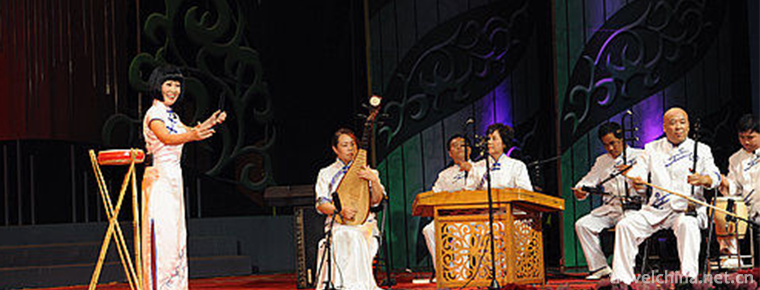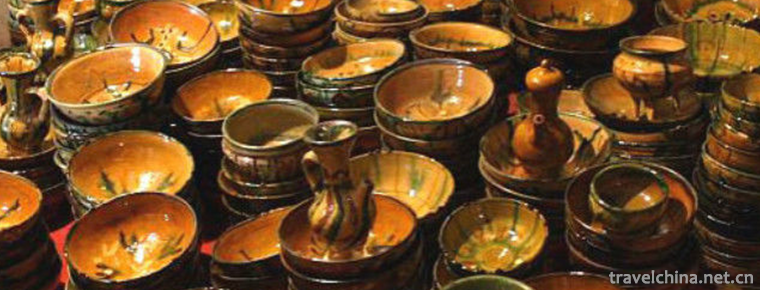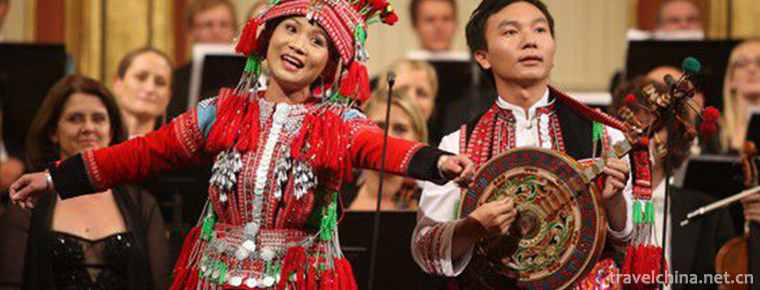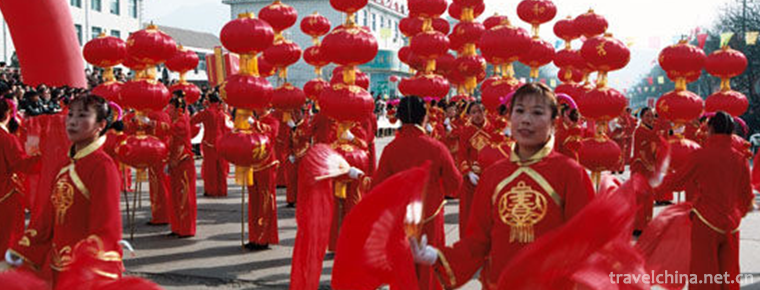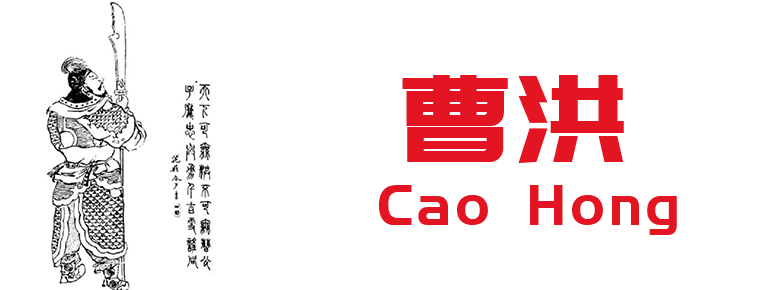Guangxi Wenchang
Guangxi Wenchang
Wenchang in Guangxi is short for Wenchang, also known as Wenjuzi and Xiaoqu. It is the traditional Solfeggio art popular in the northern Guangxi Mandarin area, especially in Guilin, Liuzhou, Lipu and other places. It is the most representative and influential traditional folk art form in Guangxi. Wenchang music is euphemistic and lingering, soft lyric. Erwenchang music can be divided into four parts: major, minor, wharf and over-the-counter music.
On June 7, 2008, the "Guangxi Wenchang" declared by Guilin City of Guangxi Zhuang Autonomous Region was listed in the second batch of national intangible cultural heritage list with the approval of the State Council.
Heritage serial number: 780V-87.
Historical origin
During the Daoguang period of the Qing Dynasty, time tune tunes in Jiangsu and Zhejiang were introduced to Guangxi, gradually merged with Guilin dialect in circulation, and influenced by local folk songs and operas. By the end of the Qing Dynasty, a Guangxi Wenchang with Guilin dialect singing and local characteristics of northern Guizhou was gradually formed. It is mainly singing, and sometimes speaking.
The form of singing is sitting and singing for several people, which can be divided into life, dan, jing, ugliness and so on. The number of singers is determined according to the characters in the song book, and each person assumes a role. Each singer also plays an accompaniment instrument, the main instrument is the dulcimer, and there are also pipa, three strings, erhu, flute, cloud board, dishes and so on. There are also costumes, costumes and singing, called "Wenchang hanging clothes". After the 1950s and 1960s, as the theatre entered the stage, standing singing appeared in the form of performance, that is, singers singing with a cloud board or disc festival, accompanied by a small band accompaniment and "walking singing" combined with singing and dancing.
Characteristics and characteristics
Guangxi Wenchang mainly sings and speaks. There are several "sitting and singing" singing forms in the theatre, accompanied by accompaniment instruments; there are "standing singing" with singing as the main form, and "walking singing" with singing and doing as the combination. In addition, there are also "literary theatres" in costume, which are called "literary theatre hanging clothes". There are life, dan, Jing and ugliness in Guangxi Wenchang. The number of singers is determined according to the characters in the song book. Each of them plays a role. After the 1950s and 1960s, as the theatre entered the stage, standing singing appeared in the form of performance, that is, singers singing with a cloud board or disc festival, accompanied by a small band and "walking singing" combined with singing and dancing.
Guangxi Wenchang Music includes major, minor, small and small entrance, introduction, tail and over-the-counter music.
Major tunes include "Yue Diao", "Tan Reed", "Silk String" and "Nanci", which are called "Four Major Tunes". They are mostly used to sing a set of scripts and singing books with stories, characters, singing, whitening and rhyming. Yue Diao is good at expressing joy, Tan Reed is good for expressing resentment, Silk String is good for expressing decay, Nanci is suitable for crying.
Most of the major lyrics are seven-word and ten-word upper and lower sentences, while the minor lyrics are mainly based on sound. Instrumental music cards, commonly known as over-the-counter music, have about 20 pieces such as "Yizhihua", "Qiluoxiang", "Wangzhuotai", which are mostly transplanted from folk music or sister operas.
In addition to "Southern Ci", each has its own derived tunes, which are called "Duo Zi" or "Duo Zi", "Class Tune", "Duo Zi" with clear rhythm and great flexibility. They are often used when the lyrics are too long and the mood needs to change.
There are more than 50 tunes in minor tunes, such as "parasitic grass", "inverted oar" and "wharf tune". Most of them are used to sing short lyric passages describing things and things, and sometimes they are also used in major tunes mainly in overshoot. In major, the lyrics are mostly seven or ten sentences, in minor, long or short sentences. The rhyme and four tones are based on Guilin dialect, while singing with emphasis on orthographic roundness. Each tune has its own characteristics. It is good at expressing different emotions of joy, anger, sorrow and joy. Its general characteristics are gentle, delicate and implicit.
Accompanied instruments, mainly yangqin, plus pipa, small three strings, huqin, flute (commonly known as "five pieces of head"), and later added tuning hu, erhu, to replace once used Yueqin and Qin with ruan. In addition to the drum, there are also dishes and so on.
The famous artists in Wenchang include Li Zizhong, Jin Zichen and Zhang Younun in the late Qing Dynasty. Wang Renhe, a well-known literary artist, made a lot of contributions to the innovation of literary music in the 1960s. He created a "complaint board" for the vocal tones of Ci in the major of Zhongnan and strengthened the artistic expression ability of the literary arena.
Art schools
The formation of art schools in Guangxi Wenchang is basically divided into professional and amateur singing styles. Most of the early professional artists in Wenchang were blind. They combined to form a "play group", or were hired to sing for a family, or to play the Huqin in the street to sell singing. Their singing voice was simple and unadorned, so they were called "blind". Some like-minded amateur amateurs form "playhouse" or "cultural club". They sing for themselves and enjoy themselves, and work together to discuss their skills. Their singing pursuit is gorgeous and colorful. They are called "Guang School". The famous singers of Guangxi Wenchang in past dynasties include Li Zizhong, Jin Zichen, Wang Renhe and Liu Yuying.
After the founding of the People's Republic of China, the competent cultural authorities of the government organized folk artists and established the Guilin Quyi Team in 1962, in which artists from the literary arena also joined. In order to develop the art of Wenchang in Guangxi, a new generation of Wenchang actors were recruited and trained. They have made great achievements under the guidance of Wang Renhe and Liu Yuying. What famous actors are Hongyu, Chen Xiufen, Yang Jifu, Li Weiqun, etc. Today, with the beautiful landscape of Guilin, Guangxi Wenchang, with its traditional artistic charm, presents itself on the stage of literature and art with new content and new means of expression.
ARIA classification
Guangxi Wenchang's music singing can be divided into major and minor. Major tunes are "Yue Diao", "Silk String", "Nanci", "Tanhuang", commonly known as "four major tunes"; minor tunes are "Overlapping Bridge", "Cutting Flowers", "Parasitic Grass" and nearly 50.
"Yue Diao" is good at expressing joy, "Tan Reed" is good for expressing resentment, "Silk String" is often used to express senility, and "Southern Ci" is suitable for crying.
In addition to the Southern Ci, each has its own derived tunes, called "Duo Zi" or "Duo Zi", "Class Tune", "Duo Zi" has a clear rhythm and great flexibility. It is often used when the lyrics are too long and the mood needs to change.
To sing stories, characters, singing, white, rhyme combination of scripts and singing albums; minor tunes now exist "parasitic grass", "inverted paddle", "wharf tune" and more than 50 music cards, mostly used to sing Lyric short passages describing everything, sometimes also in the major tune book with cross-tone as the main interlude. In major, the lyrics are mostly seven or ten sentences, in minor, long or short sentences. The rhyme and four tones are based on Guilin dialect, while singing with emphasis on orthographic roundness. Each tune has its own characteristics. It is good at expressing different emotions of joy, anger, sorrow and joy. Its general characteristics are gentle, delicate and implicit. The accompaniment instruments in Wenchang are mainly Yangqin, which is called "Five Heads" by Pipa, Xiaosanxian, Huqin and flute. Later, tuning Hu and Erhu were added, and Ruan was used instead of Yueqin and Qinqin. In addition to drum boards, Festival instruments include dishes, wine cups and so on.
There are about 50 minors such as "Ma Tou Diao", "Man Jiang Hong", "Sweeping Street", "Cursing Yulang" and "Parasitic Grass". Because of the large number and different characteristics, and a large number of liners can be used, the minor color appears more vivid and lively.
Most of the major lyrics are seven-word and ten-word upper and lower sentences, while the minor lyrics are mainly based on sound. Instrumental music cards, commonly known as over-the-counter music, have about 20 pieces, such as , , [looking at the dressing table], which are mostly transplanted from folk music or sister operas.
Major works
The traditional lyrics of Guangxi Wenchang are rich, and the contents of the songs are mostly from the Legendary Novels of Ming and Qing Dynasties. Complete sets of albums include Jade Hang Ji, White Snake Biography, Pipa Ji, West Chamber Ji, Dream of Red Mansions and other works, plus a single album "Double Down Mountain", "Wang Po Cursing Chicken" and "Eastern Shuo Shangshou" about 60. There are nearly 100 passages such as "Brother Wu Er Tour", "Drunken Damage to Mountain Gate", "Drunken Princess". New works include Jiang Zhuyun, Han Ying Seeing Her Mother, Jiang Jie Entering Mountain, Lishui Deep Feeling, etc.
In recent years, some Lyric passages eulogizing Guilin's landscape scenery have been created, such as Mid-stream Painting, How Wonderland Compares with Guilin, Seven Stars Night Tour, etc.
The representative repertoire of Guangxi Wenchang, Brother Wu Er Tan
Inheritance status
The famous singers of Guangxi Wenchang in past dynasties include Li Zizhong, Jin Zichen, Wang Renhe and Liu Yuying.
After the founding of the People's Republic of China, the competent cultural authorities of the government organized folk artists and established the Guilin Quyi Team in 1962, in which artists from the literary arena also joined. In order to develop the art of Wenchang in Guangxi, a new generation of Wenchang actors were recruited and trained. They have made great achievements under the guidance of Wang Renhe and Liu Yuying. What famous actors are Hongyu, Chen Xiufen, Yang Jifu, Li Weiqun, etc.
The number of singers is determined according to the characters in the album, each of whom has a role to play. Each singer also plays an accompaniment instrument, the main instrument is the dulcimer, and there are also pipa, three strings, erhu, flute, cloud board, dishes and so on. There are also costumes, costumes and singing, called "Wenchang hanging clothes". The concert was attended by 10 teams from Guilin City and Lipu, Lingchuan, Pingle, Liuzhou, Yizhou, Luocheng and Rongan, totaling more than 100 people. The oldest actor was 73 years old. A series of three-day performances, including "Jade Hang Ji", "White Snake Biography", "West Chamber Ji" and other famous opera excerpts, as well as "Mid-stream Painting", "Seven Stars Night Tour" and other minor tunes. After the performance, the delegates also conducted academic exchanges, discussed the history and current situation of Guangxi Wenchang, and discussed the grand plan of prospering Guangxi Wenchang.
Inheritance significance
With the beautiful landscape of Guilin, Guangxi Wenchang, with its traditional artistic charm, presents itself on the stage of literature and art with new content and new means of expression. Guangxi Wenchang is a precious intangible cultural heritage in Guangxi. It was listed in the list of intangible cultural heritage in Guangxi in 2006. On June 7, 2008, the State Council issued a notice that Guangxi Wenchang entered the second batch of national intangible cultural heritage list "Quyi" item, numbered 780V-87. The applicant is Guilin City, Guangxi Zhuang Autonomous Region. It is the duty and responsibility of Guangxi people to protect and inherit intangible cultural heritage.

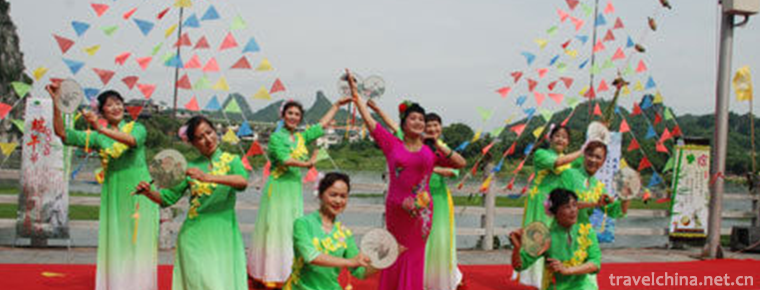
-
Shuanglang
located in the northeast of Dali City and the northeast coast of Erhai Lake.
Views: 242 Time 2018-10-17 -
Dayi Liushi Manorial Museum
Dayi Liu Manor Museum, located at No. 15 Jingui Street, Anren Town, Dayi County, Chengdu City, Sichuan Province, is one of the most important historical sites and representative buildings in modern Ch.
Views: 203 Time 2018-12-26 -
Guyuan Museum
Guyuan Museum of Ningxia was established on December 30, 1983. It belongs to the Cultural Office of Ningxia Autonomous Region. It is located at No. 133 Xicheng Road, Guyuan City, southern mountain are.
Views: 193 Time 2019-01-12 -
Puppet Head Sculpture
Zhangzhou puppet head carving is a traditional folk arts and crafts in Zhangzhou City, Fujian Province. It belongs to a special skill in the production of puppet stage props. Zhangzhou puppet head car.
Views: 102 Time 2019-06-06 -
The riddle of Qinglin Temple
The number of riddles in Qinglin Temple is abundant, there are about 5000. There are many kinds of riddles, such as object riddles, event riddles and crossword riddles. Many of the riddles have high c.
Views: 114 Time 2019-06-11 -
Sanxianshu
Sanxianshu, also known as Qianzi Shu and Leg Blackboard Shu, is an ancient traditional rap art formed in Nanyang, Henan Province. It has a history of more than 250 years. It is named for its main acco.
Views: 116 Time 2019-06-12 -
Uygur moulding earthenware firing
Uygur moulding pottery has a history of more than two thousand years. After the middle of the ninth century, Uygur ancestors moved westward to the vicinity of the Tarim Basin, inherited the pottery ma.
Views: 184 Time 2019-06-26 -
Linking Luhe boxing
Xinyi Liuhe Quan, also known as Xinyi Quan and Liuhe Quan, is one of the most famous excellent types of boxing in China, which combines fighting, fitness, self-defense and health preservation. It is o.
Views: 144 Time 2019-07-06 -
The seafood tune of the Yi nationality
The seafood tune of the Yi nationality Shiping Yi seafood tune, also known as "Shiping tune" and "Quzi", is commonly known as "inverted paddle". It is named after a herba.
Views: 315 Time 2019-07-12 -
Zuoquan Xiaohua Opera
Zuoquan Xiaohua Opera is a kind of Han folk song and dance drama which originated in Zuoquan County of Shanxi Province and spread in Yushe and Heshun areas near Zuoquan County. Its style is: one step .
Views: 238 Time 2019-08-16 -
Peking Union Medical College
The Chinese Academy of Medical Sciences was established in 1956. Peking Union Medical College was founded in 1917. Since 1957, the Chinese Academy of Medical Sciences and Peking Union Medical College .
Views: 231 Time 2019-09-06 -
Cao Hong
Cao Hong(? - two hundred and thirty two). Pei Guo Qiao (now Anhui) Bozhou People. Emperor Wei and Emperor Wei of the late Han Dynasty and the Three Kingdoms period Cao Cao From brother..
Views: 203 Time 2019-09-15

